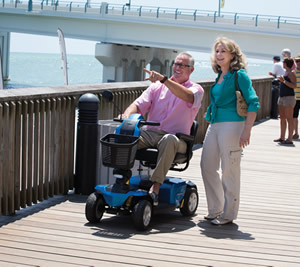Problem Solvers
Making the Right Mobility Match
The nature of standard power mobility funding has added to the complexity of how providers ensure they select the right scooter for each patient.
- By David Kopf
- Feb 01, 2016

Scooters represent the freedom to live and travel independently for patients worldwide, and have evolved to offer countless options in terms of their format (three- or four-wheeled), features, engine, seating, controls and portability. But in addition to these funding considerations, providers must also weight the patient’s funding and their condition to make a match that’s going to help them get out and enjoy life.
Scooters are a cornerstone mobility category, but it has seen a considerable amount of change in recent years. Reimbursement cuts and policy changes have essentially turned the standard power mobility and scooter market on its head.
One big change was the removal of the first month purchase option, which meant that providers had to rent all standard PMDs and scooters for 13 months. The other big change was competitive bidding, which included scooters in the products that were subject to bid. This not only radically cut reimbursement, but also meant some providers would not be able to serve markets they previously supported.
But that didn’t stop providers from helping patients get the scooters that they wanted. While providers were faced with rental business models and massive cuts, they began capitalizing on the cash sales market. Many scooter users don’t have Medicare funding, and there are Medicare beneficiaries that won’t to settle for what CMS will cover, and can afford better options.
As a result there has been an explosion of scooters that cover the spectrum of patient — and provider — needs. There are scooters that are models with a focus on durability and serviceability for the rental market, and full-featured offerings that come with all the bells and whistles, which appeal to retail customers. This means mobility patients of all funding scenarios have options.
Also, let’s not forget that client wants have also pushed the development of scooters. Scooters represent the freedom to live and travel independently for patients worldwide, and have evolved to offer countless options in terms of their format (three- or four-wheeled), features, engine, seating, controls and portability. And that’s important because there are all sorts of patients with all sorts of needs from their scooters. The result is a whole spectrum of scenarios in which a provider has to assess the patient’s condition, the patient’s needs, the patient’s wants, and the patient’s funding to come up with the right mobility match. It’s a tricky balancing act.
We sat down with Randy Walsh, vice president of Jazzy and Retail Mobility Sales for Pride Mobility Products Corp. to learn more about what goes into assessing scooter customers’ needs, and matching them with the right ride.
What are some key patient groups that depend on scooters, and how do their needs vary?
Condition-specific medical diagnoses will always be a core scooter user group. For example, those with earlier stages of progressive conditions such as ALS, MS, and MD use scooters out of sole medical necessity.
However, there’s also the ever-expanding senior population, where scooter use is more elective — and extremely popular. Seniors are more active than ever, and increasingly see scooters a way to maintain their lifestyle despite aging. Whereas walking distances gets more difficult as we age, seniors are recognizing that a travel mobility scooter, easily transported, allows them to keep going out and maintain their lifestyle.
What types of scooter features serve those unique needs?
For those with medical diagnoses, often mid-sized scooters are used for all-around mobility, with more supportive seating, more legroom for easier transfers, and highly-adjustable controls for differing abilities. Seniors seek a retail sales model where they’re making their own decision, most often on transportable compact, easy-to-use scooters.
Interestingly, seniors have also evolved a somewhat niche market of larger luxury scooters for use around expansive senior communities, where they serve as a true personal mobility vehicle, with everything from independent suspension to full automotive-style lighting to cup holders.
How does funding play a role in the selection; what does this mean for both the provider and the patient?
Scooter funding by insurers is based on functional need. This process, based on condition, is of course more obvious for some patients versus others. Yet, beyond the traditional funding model, seniors continue making the shift toward the selfpay, retail model, where they can get what they want, when they want.
As seniors have expressed via a retail mindset, a scooter is key to sustaining their lifestyle, and getting the product and features wished in real time is seen as a sense of independent decision-making toward their mobility needs. For providers, neither funding model changes the other, and it’s advantageous for providers to serve both insurer-funded and retail consumers.
However, it is important for a provider to assess the best route for each customer. For example, a customer may not be aware that self-pay is an option, able to get a great scooter immediately, at an affordable price. Similarly, a customer may not have out-of-pocket funds, but qualifies through insurer funding. Therefore, assessing and educating consumers on their options is vital.
This article originally appeared in the February 2016 issue of HME Business.
About the Author
David Kopf is the Publisher HME Business, DME Pharmacy and Mobility Management magazines. He was Executive Editor of HME Business and DME Pharmacy from 2008 to 2023. Follow him on LinkedIn at linkedin.com/in/dkopf/ and on Twitter at @postacutenews.